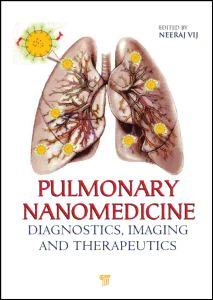
Pulmonary Nanomedicine: Diagnostics, Imaging, and Therapeutics PDF
Preview Pulmonary Nanomedicine: Diagnostics, Imaging, and Therapeutics
TThhiiss ppaaggee iinntteennttiioonnaallllyy lleefftt bbllaannkk CRC Press Taylor & Francis Group 6000 Broken Sound Parkway NW, Suite 300 Boca Raton, FL 33487-2742 © 2012 by Taylor & Francis Group, LLC CRC Press is an imprint of Taylor & Francis Group, an Informa business No claim to original U.S. Government works Version Date: 20120710 International Standard Book Number-13: 978-9-81436-414-0 (eBook - PDF) This book contains information obtained from authentic and highly regarded sources. Reason- able efforts have been made to publish reliable data and information, but the author and publisher cannot assume responsibility for the validity of all materials or the consequences of their use. The authors and publishers have attempted to trace the copyright holders of all material reproduced in this publication and apologize to copyright holders if permission to publish in this form has not been obtained. If any copyright material has not been acknowledged please write and let us know so we may rectify in any future reprint. Except as permitted under U.S. Copyright Law, no part of this book may be reprinted, reproduced, transmitted, or utilized in any form by any electronic, mechanical, or other means, now known or hereafter invented, including photocopying, microfilming, and recording, or in any information storage or retrieval system, without written permission from the publishers. For permission to photocopy or use material electronically from this work, please access www. copyright.com (http://www.copyright.com/) or contact the Copyright Clearance Center, Inc. (CCC), 222 Rosewood Drive, Danvers, MA 01923, 978-750-8400. CCC is a not-for-profit organiza- tion that provides licenses and registration for a variety of users. For organizations that have been granted a photocopy license by the CCC, a separate system of payment has been arranged. Trademark Notice: Product or corporate names may be trademarks or registered trademarks, and are used only for identification and explanation without intent to infringe. Visit the Taylor & Francis Web site at http://www.taylorandfrancis.com and the CRC Press Web site at http://www.crcpress.com To the fond memory of my parents, who taught me to seek enlightenment and knowledge and strive for excellence. Dearest souls, although you have departed and moved far away, your perpetual memory in our hearts makes us feel that you are ever near us, with us. —N.V. TThhiiss ppaaggee iinntteennttiioonnaallllyy lleefftt bbllaannkk Contents Contributors xv Preface xxi Acknowledgments xxiii 1. Theranostic A pplications of Nanotechnology in Chronic Obstructive Lung Diseases 1 Neeraj Vij and Aakruti Gorde 1.1 Pulmonary Physiology and Pathogenesis of Chronic Obstructive Lung Diseases 1 1.2 Application of Nano-Based Systems in Treating Chronic Obstructive Lung Diseases 3 1.2.1 Therapeutic and Diagnostic Challenges in Chronic Obstructive Lung Diseases 6 1.2.2 Nanosystems to Overcome Challenges in Chronic Obstructive Lung Diseases 6 1.3 Nanotheranostics 7 1.3.1 Theranostic Nanoparticles for Chronic Obstructive Lung Diseases 8 2. Multifunctional Tumor-Targeted Nanoparticles 1.3.2 Perspective 9 for Lung Cancer 15 Shinji Kuroda, Tomohisa Yokoyama, Justina O. Tam, Ailing W. Scott, Li Leo Ma, Manish Shanker, Jiankang Jin, Corbin Goerlich, David Willcutts, Jack A. Roth, Konstantin Sokolov, Keith P. Johnston, and Rajagopal Ramesha 2.1 Introduction 16 2.2 Biomarkers for Tumor Targeting 18 2.3 Nanotechnology in Medicine 20 2.3.1 Development of Nanoparticles for Lung Cancer and Other Medical Applications 20 2.3.2 Classes of Nanoparticles 23 2.3.3 Delivery Methods of Nanoparticles to Targeted Regions 26 viii Contents 2.3.3.1 Systemic Administration 26 2.3.3.2 Local Administration via Inhalation 27 2.3.3.3 Toxicity of Nanoparticles 28 2.4 EGFR-Targeted Hybrid Plasmonic Magnetic Multifunctional Nanoparticles 29 2.4.1 Structure of Nanoparticles 29 2.4.2 Therapeutic Function of EGFR-Targeted Nanoparticles 30 2.4.2.1 Inhibition of EGFR signaling pathway 30 2.4.2.2 Induction of DNA damage 32 2.4.3 Diagnostic Function of EGFR-Targeted Nanoparticles 33 3. Nasal and Pulmonary Delivery of Macromolecules 2.5 Conclusions 34 to Treat Respiratory and Nonrespiratory Diseases 45 Durga Paturi, Mitesh Patel, Ranjana Mitra, and Ashim K. Mitra 3.1 Introduction 45 3.2 Nasal Drug Delivery 46 3.2.1 Nasal Anatomy 47 3.2.2 Mechanisms of Nasal Absorption 48 3.2.3 Factors Affecting Nasal Absorption 50 3.2.3.1 Physiological factors 50 3.2.3.2 Pathological conditions 50 3.2.3.3 Biochemical changes 52 3.2.3.4 Physicochemical properties of the permeant 52 3.2.3.5 Properties of the formulation 53 3.2.3.6 Drug distribution 54 3.2.3.7 Device-related factors 54 3.2.4 Strategies to Enhance Nasal Absorption 55 3.2.4.1 Cyclodextrins 56 3.2.4.2 Fusidic acid derivatives 56 3.2.4.3 Phospholipids 56 3.2.4.4 Bile salt derivatives 56 3.2.4.5 Peptidase and protease inhibitors 57 3.2.5 Nasal Formulations 57 Contents ix 3.2.5.1 Nasal drops 59 3.2.5.2 Nasal sprays 59 3.2.5.3 Nasal powders 60 3.2.5.4 Nasal ointments and emulsions 60 3.2.5.5 Nasal gels 61 3.2.5.6 Liposomes 62 3.2.5.7 Nanoparticles 63 3.2.5.8 Microparticles 65 3.2.6 Nasal Delivery of Vaccines 66 3.2.7 Intranasal Gene Delivery 67 3.3 Pulmonary Drug Delivery 69 3.3.1 Anatomy of the Lungs 70 3.3.2 Pulmonary Absorption 72 3.3.3 Barriers in Pulmonary Drug Delivery 73 3.3.4 Formulations 74 3.3.4.1 Micelles 74 3.3.4.2 Liposomes 75 3.3.4.3 Microparticles 76 3.3.4.4 Nanoparticles 77 3.3.4.5 Microemulsions 79 3.3.5 Inhalation Devices 82 3.3.5.1 Pressurized metered-dose inhaler (pMDI) 83 3.3.5.2 Nebulizers 84 3.3.5.3 Dry powder inhalers 85 3.3.6 Factors Affecting Pulmonary Deposition 85 3.3.7 Vaccines 86 3.3.8 Nucleic Acids 87 3.3.9 Oligonucleotides 91 4. In vitro and in vivo Diagnosis of Pulmonary Disorders 3.4 Conclusions 92 Using Nanotechnology 103 Indrajit Roy 4.1 Introduction 103 4.2 Nanoparticles 104
